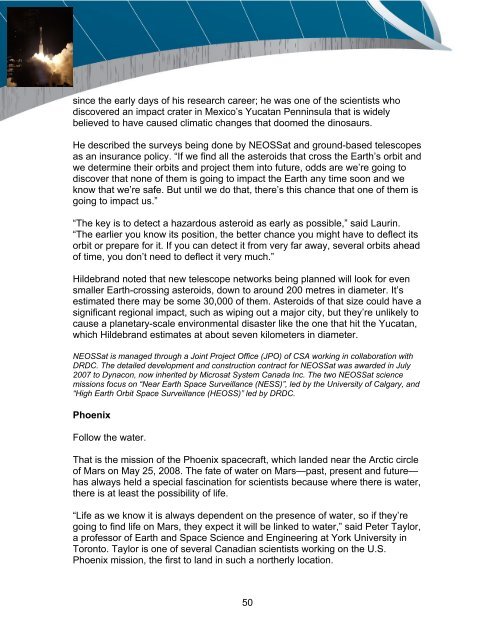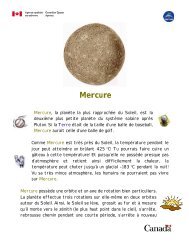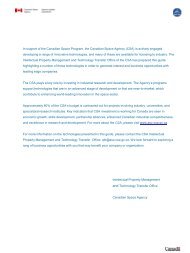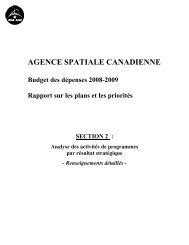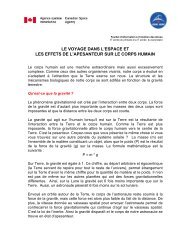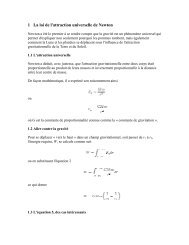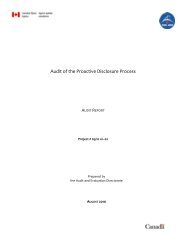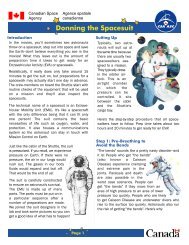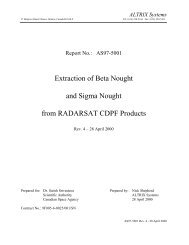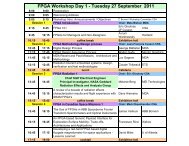PDF version of COSPAR - Space Science Research in Canada Report
PDF version of COSPAR - Space Science Research in Canada Report
PDF version of COSPAR - Space Science Research in Canada Report
Create successful ePaper yourself
Turn your PDF publications into a flip-book with our unique Google optimized e-Paper software.
s<strong>in</strong>ce the early days <strong>of</strong> his research career; he was one <strong>of</strong> the scientists whodiscovered an impact crater <strong>in</strong> Mexico’s Yucatan Penn<strong>in</strong>sula that is widelybelieved to have caused climatic changes that doomed the d<strong>in</strong>osaurs.He described the surveys be<strong>in</strong>g done by NEOSSat and ground-based telescopesas an <strong>in</strong>surance policy. “If we f<strong>in</strong>d all the asteroids that cross the Earth’s orbit andwe determ<strong>in</strong>e their orbits and project them <strong>in</strong>to future, odds are we’re go<strong>in</strong>g todiscover that none <strong>of</strong> them is go<strong>in</strong>g to impact the Earth any time soon and weknow that we’re safe. But until we do that, there’s this chance that one <strong>of</strong> them isgo<strong>in</strong>g to impact us.”“The key is to detect a hazardous asteroid as early as possible,” said Laur<strong>in</strong>.“The earlier you know its position, the better chance you might have to deflect itsorbit or prepare for it. If you can detect it from very far away, several orbits ahead<strong>of</strong> time, you don’t need to deflect it very much.”Hildebrand noted that new telescope networks be<strong>in</strong>g planned will look for evensmaller Earth-cross<strong>in</strong>g asteroids, down to around 200 metres <strong>in</strong> diameter. It’sestimated there may be some 30,000 <strong>of</strong> them. Asteroids <strong>of</strong> that size could have asignificant regional impact, such as wip<strong>in</strong>g out a major city, but they’re unlikely tocause a planetary-scale environmental disaster like the one that hit the Yucatan,which Hildebrand estimates at about seven kilometers <strong>in</strong> diameter.NEOSSat is managed through a Jo<strong>in</strong>t Project Office (JPO) <strong>of</strong> CSA work<strong>in</strong>g <strong>in</strong> collaboration withDRDC. The detailed development and construction contract for NEOSSat was awarded <strong>in</strong> July2007 to Dynacon, now <strong>in</strong>herited by Microsat System <strong>Canada</strong> Inc. The two NEOSSat sciencemissions focus on “Near Earth <strong>Space</strong> Surveillance (NESS)”, led by the University <strong>of</strong> Calgary, and“High Earth Orbit <strong>Space</strong> Surveillance (HEOSS)” led by DRDC.PhoenixFollow the water.That is the mission <strong>of</strong> the Phoenix spacecraft, which landed near the Arctic circle<strong>of</strong> Mars on May 25, 2008. The fate <strong>of</strong> water on Mars—past, present and future—has always held a special fasc<strong>in</strong>ation for scientists because where there is water,there is at least the possibility <strong>of</strong> life.“Life as we know it is always dependent on the presence <strong>of</strong> water, so if they’rego<strong>in</strong>g to f<strong>in</strong>d life on Mars, they expect it will be l<strong>in</strong>ked to water,” said Peter Taylor,a pr<strong>of</strong>essor <strong>of</strong> Earth and <strong>Space</strong> <strong>Science</strong> and Eng<strong>in</strong>eer<strong>in</strong>g at York University <strong>in</strong>Toronto. Taylor is one <strong>of</strong> several Canadian scientists work<strong>in</strong>g on the U.S.Phoenix mission, the first to land <strong>in</strong> such a northerly location.50


